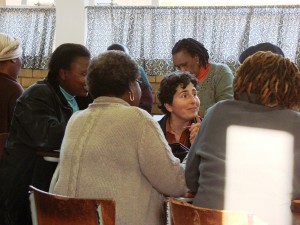
Now that I’ve returned from South Africa and am back in my classroom in Oregon, the overwhelming differences between my daily work here, my students, my teaching environment, and that of the South African teachers is impossible to get out of my mind.
In my US classroom, I see paper in the recycling bin that’s still blank on one side, so I fish it out for reuse, remembering the teachers who had no notebooks, meticulously writing their science notes in the thin margins of their government-issued calendars.
I see the pencil cases my US students carry, stocked with wooden pencils, mechanical pencils, highlighters, sharpies, erasers in cute shapes, protractors, and graphing calculators, and think of the grubby inch-long pencil stubs South African kids used, shaved to a point with a penknife. I had never seen pencils so short, but the kids got by well enough with them, so why not? Upon realizing that we were running out of pencils during our math workshop at the Memezile School, I took one of the nice long pencils we’d brought from the US, snapped it into 3 pieces, sharpened the ends with my Swiss Army knife, and passed them out. The kids grinned.
At Catlin this semester, my biggest class is 18 students, and that’s considered on the large side. I have a total of 62 students in 5 courses. That’s fewer students than many rural South African teachers have in a single class. One teacher will work with hundreds of students in one day. Teaching is not a very sought-after profession, especially in rural areas, and young people who show promise often go into more lucrative fields. Students with science and math aptitude are drawn to engineering, not education, careers. The teachers instructing science and math classes often don’t have training in the topics they’re teaching. I met a surprising number of teachers who were trained in religious education, but were now in science classrooms, doing the best they could.
At the beginning of each TABSA workshop, I wanted to get to know the participants a bit and find out about each person’s teaching situation. I passed out paper and asked for a description of what classes they taught, how many students they had, what resources were available to them, their teacher training and experience, and for them to identify some of the key problems they were facing in their work.
Late at night, reading their responses in my sparse dorm room at the Sybrand Van Niekerk School in Sabie, I was hit in the gut with the reality of modern South Africa. They wrote about teen pregnancy, drugs, HIV, orphans, illiteracy, gangs, 80+ kids in a classroom, hungry kids, no supplies, and scant professional development opportunities. It was absolutely overwhelming. I felt useless in the face of all that these teachers must deal with on a daily basis. And yet they spent their precious vacation time at our workshop, away their families for a week, ready to soak up all that we had to offer. Their commitment was incredible.
Before going to South Africa, Yunus, our indefatigable director, advised our team to examine the new South African curriculum so that we could make our workshops as directly relevant as possible. When first I clicked onto the South Africa Department of Basic Education website, I was taken aback by how polished it appeared. “Every child is a national asset…” the banner at the top proclaims. The core values described on this site are laudable, but the reality is that Mpumalanga ranks 9th out of 9 provinces on the Annual National Assessment scores, and science and math are particularly weak areas. Witnessing the stratification of education – often of higher quality in urban areas, and even better if you can afford to pay – I couldn’t help but wonder what this inequality means for the future of the nation. Which groups will hold the social and economic power, and who will be subservient? What will it take to break this vicious cycle of inequality?
I had expected that my role would be to supply ideas for teaching the new South African curriculum without specialized science equipment, but I soon realized that it was also necessary to shore up the teachers’ own fundamental understanding of the science we were studying, as well as provide pedagogical insight. Most teachers had not received adequate training to be able to teach their courses, and that was something I could directly address in our workshops. They would occasionally have some scientific vocabulary, but often lacked an understanding of what the words meant and of how to articulate the concept the term described.
So, we learned by doing. We studied variation in populations by creating histograms of the group’s physical traits. We organized and rearranged dried beans to demonstrate the flow of matter and energy through the ecosystem. We represented infectious disease spreading through a population with red cabbage juice. We used dozens of paper scraps to model change in a bacterial population over time. We acted out interaction between human body systems with a rousing activity that had everyone running around in circles on a cold sunny morning, red-faced, laughing, and ultimately realizing that playing silly games really can help one better understand a tricky concept.
My improvisational skills got lots of practice and my classroom creativity and flexibility were definitely put into action. The teachers hadn’t experienced actively participating in a workshop. They were not accustomed to being given a challenging problem and having to work with each other to puzzle through it. They were not used to removing technical terms from a conversation to discuss a concept in simple language. TABSA’s entire approach: activity-based, participant-driven workshops emphasizing analytical thinking skills, was foreign to them. And yet, despite the novelty of what we were asking them to do, every single cohort of teachers had high spirits and open minds.
A key lesson I learned through my participation in TABSA is the incredible complexity of resolving South Africa’s current state of affairs. Apartheid may be over and a progressive new constitution in place, but this is just the beginning. The 18 year old nation is like a gawky teenager, still growing into his body, figuring out how to move with coordination and grace. There are no easy solutions to the inequalities in education, health, housing, gender parity, and other social issues, and it’s going to take a long, long time for the country to reach a point at which every child really can live up to her potential as a national asset. Still, I am profoundly appreciative for having had the opportunity to experience this complexity firsthand, and I’m grateful to everyone who made this experience possible for me. I draw a great deal of inspiration from the good will of the TABSA team and the tenacity of the South African and Swazi people – teachers, students, administrators, community members – with whom I was privileged to interact.
